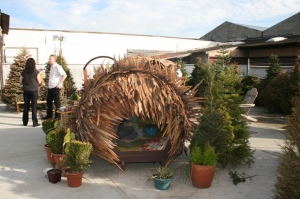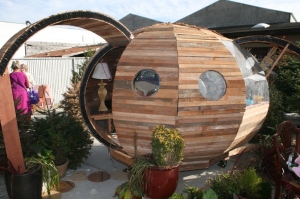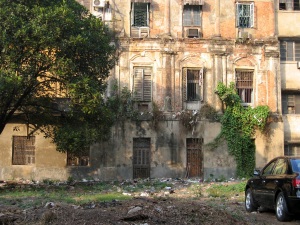Byxbee Park, on the bay shore in Palo Alto, is both perfectly obvious and perfectly bizarre. Obvious, because it’s in the middle of the Baylands and offers spectacular views of the bay in all directions. Perfectly bizarre, because it is full of machinery and mysterious artifacts that have an allure similar to Stonehenge. Clearly these things were built by humans, and at some effort, but to what earthly purpose?

- Pole Field at Byxbee Park, Palo Alto
The artifacts include a carefully planted forest of wooden poles, as well as a piece of equipment that looks like a cross between a rugby goal and wind chimes. K-rail is laid out in chevrons on one hillside. In a dip on the other side, stands a chugging, churning device that looks to have sagged out of plumb a generation ago. A trail of shimmery heat waves comes out the top.
Most startlingly, the place breathes, though not always in the same rhythm. A few years ago, you had to listen carefully for the long-drawn-out, despondent sigh it cast upon the air every two minutes or so. When I visited more recently, the park breathed almost in synch with myself, a little stertorously perhaps, as if suffering from some minor pulmonary obstruction.
There’s a simple explanation for the mystery: Byxbee Park is repurposed landfill, a small section of the Palo Alto city dump that was decommissioned some time in the 1980s. Its artificial hills are studded with pipes and pumps for the capture of leachate and methane. The leachate goes to the purification plant down the road, while the methane is burned off by a flare, that rusty device described above. Construction rubble peeks out of the grassy knolls behind the “habitat reconstruction” signs. The pole forest is in fact “land art,” and so are the K-rail and the rugby chimes.
If you don’t already know, then it’s not so easy to find out what Byxbee Park is. A plaque near the entrance to the park says: “The design of Byxbee Park is the result of a collaboration between the City of Palo Alto, landscape architects Hargreaves Associates, and artists Michael Oppenheimer and Peter Richards. The project was funded in part by the City of Palo Alto refuse collection fees and the Public Art Commission’s Art in Public Places program.” A map identifies the installations by name but declines all effort at explanation. And not a word about garbage apart from those collection fees.
Byxbee’s tight-lipped stance, the likely legacy of the 20th-century’s long romance with “sanitation,” is perhaps understandable. Sanitation was about garbage removal as a public health measure, about whisking garbage away from the curb and making it disappear, as quickly and efficiently as possible. It was about burying garbage where nobody had to worry about it except the sanitation department. It was about creating a world where you could pretend that garbage didn’t really amount to any of your business. That time has passed.
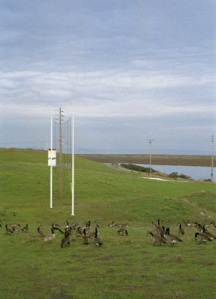
Wind Wave installation
The sanitation romance is fading and reality asserts itself. What may once have counted as innocence now only looks like wanton blindness. Most of us are uncomfortably aware of the fact that natural resources are finite and landfill space harder and harder to come by. Sanitary engineering has given way to environmental engineering, and ordinary people are handling (and worrying about) their trash, at least a little. When we drag our garbage cans to the curb and the lid won’t quite go down, we probably don’t feel too good about it.
All the same, it’s still awkward to talk about garbage publicly. The instinct still is to pull away from the subject as if it were sex and we Victorians. Garbage isn’t quite taboo, but it isn’t approved cocktail party conversation either—or something easily owned up to in park signage. It’s not just Byxbee Park where the “habitat restoration” signs don’t specify what type of habitat it is exactly that’s being restored. Bayfront Park, in Menlo Park, doesn’t have a single sign telling you it’s the old town dump. The Sunnyvale dump has signs all over it that say “Sensitive Wildlife Area.” Indeed.
Garbage dumps are just more comfortable telling you how to comport yourself than pointing out what it is you’ve already accomplished.
But perhaps it’s time to learn to think about garbage and to discuss it, not just in the “trashies” subculture but in polite society—if only because we actually feel a little guilty about the amounts of trash we get rid of every week. Or perhaps because we suspect that, whatever happens to it precisely, it’s not a pretty story. Perhaps because looking at our garbage makes it possible to decide whether we want to continue to make more fake hills and fill up more canyons with dangerous stuff that needs to be tended and monitored for decades or longer. If we dig our garbage back up out of the twilit reaches of a guilty conscience, then perhaps the signage at our landfills can be a little more straightforward too?
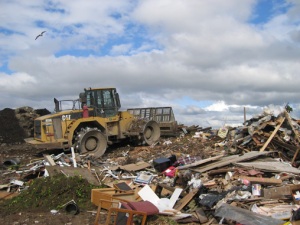
Totting up donations on the Palo Alto dump
At Byxbee right now, the best hint of what’s underfoot is the active fill next door. Its mounds rise at a startling rate, even though only a portion of Palo Alto’s garbage ends up here now. Every time I visit Byxbee, the new dump is a little more present. One day, a new hill rises in the back. Another time, fill activity is going on in front, where there used to be a miscellany of trucks, rubble, equipment, and temporary storage. A third time, a little setup of pumps and other machinery has been moved out of the hollow in which it sat, and the hollow itself is now a big hill. It’s all carefully shaped to a grading plan that is meant to make the garbage look like the Coyote Hills across the bay–a natural feature of the environment.
With only a few years of space left in it, the active dump is expected to reach capacity in 2010, and the entire area will become parkland. As garbage hills go, Byxbee won’t be very large. Nevertheless, if it’s your garbage in there, how is it not special?
Even when you know what it is made of, Byxbee is quite lovely. Or maybe it is actually more lovely. In summer, when the grass is a bright strawberry blond and the sky intensely blue, the garbage is more a distant memory than a looming presence. Christmastime is different. The park has a leaden quality, even on the brighter days. The dull green of the grass and the relatively low light lend the hills an ominous air far more suggestive of the putrid mess underfoot.
In winter, the geese come through on their way south. Large groups, sometimes hundreds of them, camp out for a day or so to rest. The younger members of the flock occupy their time with incessant honking, squawking, and squabbling to rearrange the social order, while the more sedate and peaceable members of the congregation contentedly snack on the new grass.
The pelicans like to doze near Adobe Creek, neatly folded into small, blazing white packages from which occasionally a gawky long neck and beak protrudes. They could be a demonstration of the amazing ingenuity of a high-tech camping gadget. An occasional loner on the wing, flying low over the water, demonstrates the size and power of the animal when fully folded out.
At sunrise the wading birds and other water fowl are out at first light, always already there by the time I arrive. Most of the smaller ones I don’t recognize, although I am familiar with the names: terns, grebes, willets, western sandpipers, curlews, greater and lesser yellowlegs. They roll on the tongue like burbling water, out of time and history, comforting like the birds themselves.
They offer us a little hope: no matter how artificial the environment, no matter how degraded, life goes on. For now at least.
